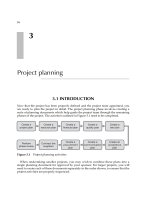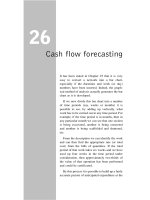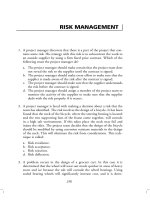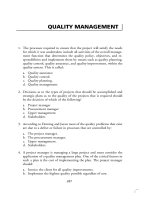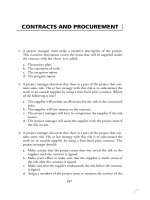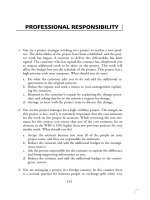Agile Project Management and the Real World doc
Bạn đang xem bản rút gọn của tài liệu. Xem và tải ngay bản đầy đủ của tài liệu tại đây (2.25 MB, 73 trang )
Agile Project Management
and the Real World
Emily Lynema
DLF Fall 2010
November 1, 2010
Outline
• Why care about project management?
• Traditional vs. Agile
• What is Agile?
• What is Scrum?
• Agile case study: NCSU
• Making choices
• Resources
Why care?
• You have too much to do
• NCSU Libraries
– 6 developers
– 33 Digital Library staff
– >250 library staff
• Core Information Systems
– 3 full-time developer positions
– 18 supported applications
– 10 in active developmentWhat makes it harder?
• Priorities change frequently
• Requirements change frequently
• No defined business analysts
• Emergencies happen every day
• Many projects across few people
• Everyone handles full life cycle
And it keeps going….
• IT black box
– How long?
– When will it be ready?
– When will you work on my stuff?
– Are you actually doing anything?
– What do I have to do to get something
done?
Traditional Project
Management
……
…….
• A project is still a project:
– Vision
– Life cycle
– Requirements
– Schedule
– Team
– Communication mechanisms
Project Life Cycle
Agile: iterative
1. Envision
2. Speculate
3. Explore
4. Adapt
5. Close
6. Repeat 3 – 5 as
necessary
Traditional: waterfall
1. Initiate
2. Plan
3. Define
4. Design
5. Build
6. Test
Taken from Highsmith, James (2010). Agile project
management: creating innovative products
What‟s different?
• Traditional
– Plan all in advance
– Work-breakdown
structure
– Functional specs
– Gantt chart
– Status reports
– Deliver at the end
– Learn at the end
– Follow the plan
– Manage tasks
• Agile
– Plan as you go
– Feature-breakdown
structure
– User stories
– Release plan
– Story boards
– Deliver as you go
– Learn every iteration
– Adapt everything
– Manage team
What is Agile?
“Agile development is a method of
building software by empowering and
trusting people, acknowledging
change as norm, and promoting
constant feedback”
Shuh, Peter (2005). Integrating Agile Development in the Real
World. p.2.
What is Agile?
“The formula for success is simple: deliver
today, adapt tomorrow. ”
Highsmith, James (2010). Agile project management: creating
innovative products. p.29.
What is Agile?
• Response to waterfall approach
• Values:
– Individuals and interactions
– Working software
– Customer collaboration
– Responding to change
Manifesto for Agile Software Development. Accessible at
/>1. Our highest priority is to satisfy the
customer through early and
continuous delivery of valuable
software.
Agile Principles
Manifesto for Agile Software Development. Accessible at
/>2. Welcome changing requirements,
even late in development. Agile
processes harness change for the
customer's competitive advantage.
Agile Principles
Manifesto for Agile Software Development. Accessible at
/>Agile Principles
3. Deliver working software frequently,
from a couple of weeks to a couple of
months, with a preference to the
shorter timescale.
Manifesto for Agile Software Development. Accessible at
/>Agile Principles
4. Business people and developers
must work together daily throughout
the project.
Manifesto for Agile Software Development. Accessible at
/>Agile Practices - Managerial
• Collocate team members and
customers
• Allow team members to make decisions
• Maintain quality of work life
• Use information radiators for
transparency and accountability
• Daily stand-up meetings
• Regularly evaluate processes
Agile Practices - Technical
• Build automation
• Automated deployment
• Continuous integration
• Simple design
• Collective ownership
• Refactoring
• Pair programming
Project Life Cycle
Agile: iterative
1. Envision
2. Speculate
3. Explore
4. Adapt
5. Close
6. Repeat 3 – 5 as
necessary
Traditional: waterfall
1. Initiate
2. Plan
3. Define
4. Design
5. Build
6. Test
Taken from Highsmith, James (2010). Agile project
management: creating innovative products
Envision
• Initiate project
• Develop project vision, objectives, and
constraints
• Create a core team
• High-level feature list
Speculate
• Plan and Define project
• Gather initial broad requirements
• Create initial backlog of features with
user stories
• Develop iterative high-level release plan
– Velocity + story points
– Must be adaptable over time!




